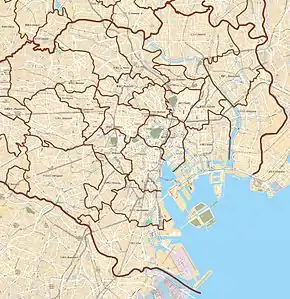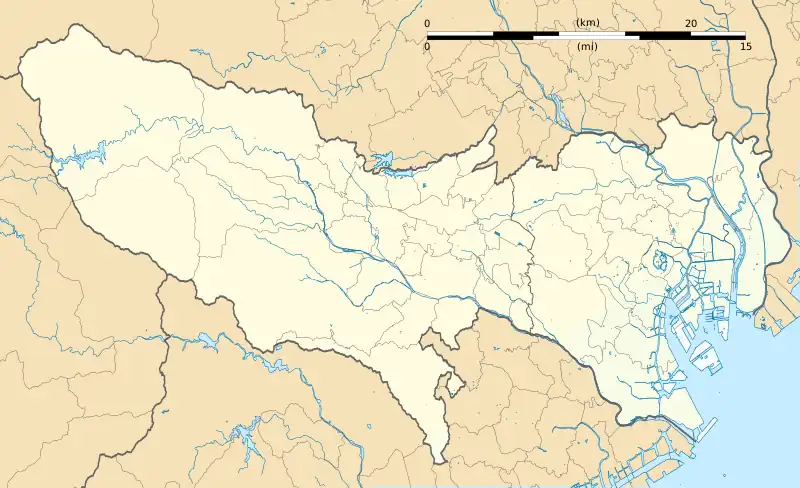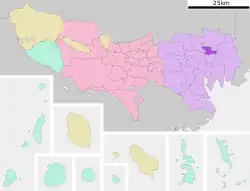JY08 JK33 C16 NT02 Nishi-Nippori Station 西日暮里駅 | ||||||||||||||||||||||||||||||||||||
|---|---|---|---|---|---|---|---|---|---|---|---|---|---|---|---|---|---|---|---|---|---|---|---|---|---|---|---|---|---|---|---|---|---|---|---|---|
 The JR East platforms viewed from the west side in June 2015 | ||||||||||||||||||||||||||||||||||||
| General information | ||||||||||||||||||||||||||||||||||||
| Location | 5 Nishi-Nippori, Arakawa-ku, Tokyo Japan | |||||||||||||||||||||||||||||||||||
| Operated by | ||||||||||||||||||||||||||||||||||||
| Line(s) | ||||||||||||||||||||||||||||||||||||
| Connections | ||||||||||||||||||||||||||||||||||||
| Other information | ||||||||||||||||||||||||||||||||||||
| Station code |
| |||||||||||||||||||||||||||||||||||
| History | ||||||||||||||||||||||||||||||||||||
| Opened | 20 December 1969 | |||||||||||||||||||||||||||||||||||
| Passengers | ||||||||||||||||||||||||||||||||||||
| JR East, FY2013 | 97,268 daily | |||||||||||||||||||||||||||||||||||
| Services | ||||||||||||||||||||||||||||||||||||
| ||||||||||||||||||||||||||||||||||||
| Location | ||||||||||||||||||||||||||||||||||||
 Nishi-Nippori Station Location within Special wards of Tokyo  Nishi-Nippori Station Nishi-Nippori Station (Tokyo)  Nishi-Nippori Station Nishi-Nippori Station (Japan) | ||||||||||||||||||||||||||||||||||||
Nishi-Nippori Station (西日暮里駅, Nishi-Nippori-eki) is a railway station in Arakawa, Tokyo, Japan, operated jointly by East Japan Railway Company (JR East) and the two Tokyo subway operators Tokyo Metro and Toei.
Lines
Nishi-Nippori Station is served by the following lines.
Platforms
JR East
The JR East station consists of two island platforms serving four tracks.
| 1 | JK Keihin-Tōhoku Line | for Tokyo, Shinagawa, and Yokohama |
| 2 | JY Yamanote Line | for Tokyo and Shinagawa |
| 3 | JY Yamanote Line | for Tabata, Ikebukuro, and Shinjuku |
| 4 | JK Keihin-Tōhoku Line | for Tabata, Akabane, and Ōmiya |
 Platforms 1 and 2
Platforms 1 and 2 Platforms 3 and 4
Platforms 3 and 4
Tokyo Metro
The Chiyoda Line station consists of two underground split side platforms, with platform 1 on the upper level and platform 2 on the lower level.
| 1 | C Chiyoda Line | for Otemachi and Yoyogi-uehara |
| 2 | C Chiyoda Line | for Kita-senju, Ayase and Kita-ayase JL Joban Line (Local) for Matsudo, Kashiwa and Toride (via Ayase) |
 The ticket barriers for transferring between JR East and the Tokyo Metro Chiyoda Line, June 2019
The ticket barriers for transferring between JR East and the Tokyo Metro Chiyoda Line, June 2019 Chiyoda Line platforms, November 2019
Chiyoda Line platforms, November 2019
Toei
The Nippori-Toneri Liner station is elevated and consists of a single island platform serving two tracks.
| 1 | NT Nippori-Toneri Liner | for Nippori |
| 2 | NT Nippori-Toneri Liner | for Kumanomae, Nishiaraidaishi-nishi, and Minumadai-shinsuikoen |
 The Nippori-Toneri Liner platforms, July 2021
The Nippori-Toneri Liner platforms, July 2021
History
The Chiyoda Line station opened on 20 December 1969.[1] The Yamanote Line station opened on 20 April 1971.[2] The Nippori-Toneri Liner station opened on 30 March 2008.[3]
The station facilities of the Chiyoda Line were inherited by Tokyo Metro after the privatization of the Teito Rapid Transit Authority (TRTA) in 2004.[4]
Station numbering was introduced in 2016 with Nishi-Nippori being assigned station numbers JY08 for the Yamanote line and JK33 for the Keihin-Tōhoku line.[5][6] Numbering was expanded to the Nippori-Toneri Liner platforms in November 2017 with the station receiving station number NT02.[7]
Passenger statistics
In fiscal 2013, the JR East station was used by an average of 97,268 passengers daily (boarding passengers only), making it the 41st-busiest station operated by JR East.[8] In fiscal 2013, the Tokyo Metro station was used by an average of 162,852 passengers per day (exiting and entering passengers), making it the fifteenth-busiest station operated by Tokyo Metro.[9] Over the same fiscal year, the Toei station was used by an average of 10,500 per day (boarding passengers only), making it the second-busiest station on the Nippori-Toneri Liner.[10] The daily average passenger figures for JR East and Tokyo Metro in previous years are as shown below.
| Fiscal year | JR East | Tokyo Metro |
|---|---|---|
| 2000 | 96,355[11] | |
| 2005 | 87,392[12] | |
| 2010 | 94,059[13] | |
| 2011 | 93,891[14] | 156,404[15] |
| 2012 | 94,884[16] | 158,555[17] |
| 2013 | 97,268[8] | 162,852[9] |
- Note that JR East figures are for boarding passengers only.
Surrounding area
- Ogubashi-dōri Street
- Dōkanyama-dōri Avenue
- Kaisei Junior & Senior High School
See also
References
- ↑ Terada, Hirokazu (19 January 2013). データブック日本の私鉄 [Databook: Japan's Private Railways]. Japan: Neko Publishing. p. 215. ISBN 978-4-7770-1336-4.
- ↑ 日本国有鉄道停車場一覧 [JNR Station Directory]. Japan: Japanese National Railways. 1985. p. 97. ISBN 4-533-00503-9.
- ↑ "新交通システム「日暮里・舎人線」(仮称)路線名・駅名決定!" [New transportation system "Nippori-Toneri Line" (provisional name) route name and station name decided!]. kotsu.metro.tokyo.jp (in Japanese). 13 November 2006. Archived from the original on 1 May 2008. Retrieved 26 December 2022.
- ↑ "「営団地下鉄」から「東京メトロ」へ" [From "Teito Rapid Transit Authority" to "Tokyo Metro"]. Tokyo Metro Online (in Japanese). 2006-07-08. Archived from the original on 16 May 2012. Retrieved 29 May 2022.
- ↑ "⾸都圏エリアへ 「駅ナンバリング」を導⼊します" [Introduce “station numbering” to the Tokyo metropolitan area] (PDF). jreast.co.jp (in Japanese). 6 April 2016. Archived from the original (PDF) on 7 December 2022. Retrieved 7 January 2023.
- ↑ Kusamachi, Yoshikazu (7 April 2016). "JA・JK・JT・AKB…JR東日本、首都圏で駅ナンバリングなど導入へ" [JA, JK, JT, AKB … JR East to introduce station numbering in the Tokyo metropolitan area]. Response Automotive Media (in Japanese). Archived from the original on 6 August 2022. Retrieved 7 January 2023.
- ↑ "東京さくらトラム(都電荒川線)及び日暮里・舎人ライナーに「駅ナンバリング」を導入いたします" ["Station numbering" will be introduced on the Tokyo Sakura Tram (Toden Arakawa Line) and the Nippori-Toneri Liner.] (PDF). kotsu.metro.tokyo.jp (in Japanese). 16 November 2017. Archived from the original (PDF) on 19 January 2019. Retrieved 26 December 2022.
- 1 2 各駅の乗車人員 (2013年度) [Station passenger figures (Fiscal 2013)] (in Japanese). Japan: East Japan Railway Company. Retrieved 15 September 2014.
- 1 2 各駅の乗降人員ランキング [Station usage ranking] (in Japanese). Tokyo Metro. Retrieved 15 September 2014.
- ↑ 各駅乗降人員一覧 [Passenger statistics for each station] (in Japanese). Tokyo Metropolitan Bureau of Transportation. Retrieved 14 September 2014.
- ↑ 各駅の乗車人員 (2000年度) [Station passenger figures (Fiscal 2000)] (in Japanese). Japan: East Japan Railway Company. Retrieved 1 August 2013.
- ↑ 各駅の乗車人員 (2005年度) [Station passenger figures (Fiscal 2005)] (in Japanese). Japan: East Japan Railway Company. Retrieved 1 August 2013.
- ↑ 各駅の乗車人員 (2010年度) [Station passenger figures (Fiscal 2010)] (in Japanese). Japan: East Japan Railway Company. Retrieved 1 August 2013.
- ↑ 各駅の乗車人員 (2011年度) [Station passenger figures (Fiscal 2011)] (in Japanese). Japan: East Japan Railway Company. Retrieved 1 August 2013.
- ↑ 駅別乗降人員順位表(2011年度1日平均) [Station passenger figures (Fiscal 2011)] (in Japanese). Japan: Tokyo Metro. Retrieved 15 September 2014.
- ↑ 各駅の乗車人員 (2012年度) [Station passenger figures (Fiscal 2012)] (in Japanese). Japan: East Japan Railway Company. Retrieved 15 September 2014.
- ↑ 各駅の乗降人員ランキング (2012年) [Station usage ranking (2012)] (in Japanese). Tokyo Metro. Retrieved 15 September 2014.
External links
- Nishi-Nippori Station (JR East) (in Japanese)
- Nishi-Nippori Station (Tokyo Metro) (in English)
- Nishi-Nippori Station (Toei) (in Japanese)
